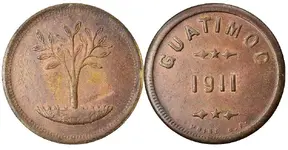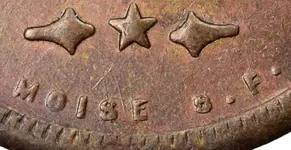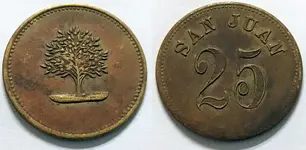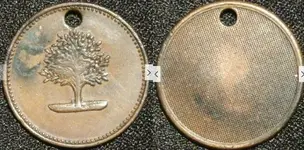Here are a couple others so that you can see the design more clearly. That reverse crosshatching reminds me of these tree tokens. They may have been made by the same company.
Well done on finding the other examples. Dr Google gave me zilch using appropriate search terms but, annoyingly, google.com automatically diverts me to google.co.uk and then doesn’t capture all the possibilities. Fleabay usually does the same diversion to the UK site.
Solved it may be in terms of now knowing what the imagery is, but not who made this, when, or why. If it had been a button (clearly not) it would happily sit in the fairytale/storybook category of picture buttons… and maybe there are fobs of this type too.
The ‘tree token’ you showed is generally referenced as from the Guatimoc coffee plantation in Mexico from 1911 although I don’t know if that’s 100% reliable. Various mentions of it all seem to rely on the same anecdotal source without further substantiation. There are
similar tokens which are dated and have the Guatimoc attribution with a 1911 date rather than a cross-hatched back:


Note that the one above, and other varieties of the token without the tree, have the maker mark for L.H. Moise of San Franciso (Moise-Klinker from 1898, although both the Moise name and the Klinker name continued to be used individually into the 1900s). They made all kinds of metal bits and pieces including tokens, medallions and key fobs.
There are other tokens using what seems to be the
same tree design, more reliably attributed as from coffee plantations such as this one from Guatemala, but it has a value of 25 centavos on the reverse and no indication that it was produced by Moise:

I still think this is not a token, and don't know who produced it, but probably not Moise (in the absence of a maker mark).









